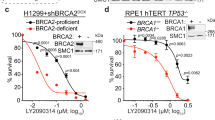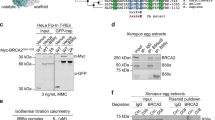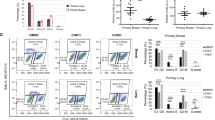Abstract
Germline mutations in the BRCA1 gene are associated with an increased susceptibility to the development of breast and ovarian cancers. Evidence suggests that BRCA1 protein plays a key role in mediating DNA damage-induced checkpoint responses. Several studies have shown that ectopic expression of BRCA1 in human cells can trigger cellular responses similar to those induced by DNA damage, including G2/M cell cycle arrest and apoptosis. While the effects of ectopic BRCA1 expression on the G2/M transition and apoptosis have been extensively studied, the factors that dictate the balance between these two responses remain poorly understood. We have recently shown that ectopic expression of BRCA1 in MCF-7 human breast cancer cells resulted in activation of extracellular signal-regulated protein kinase 1 and 2 (ERK1/2) and G2/M cell cycle arrest. Furthermore, inhibition of BRCA1-induced ERK1/2 activation using mitogen-activated protein kinase kinase 1 and 2 (MEK1/2)-specific inhibitors resulted in increased apoptosis, suggesting a potential role of ERK1/2 kinases in BRCA1-mediated G2/M checkpoint response. In this study, we assessed the role of ERK1/2 kinases in the regulation of BRCA1-mediated G2/M cell cycle arrest. Results indicate that BRCA1-induced G2/M cell cycle arrest and ERK1/2 activation correlate with changes in the level and/or activity of several key regulators of the G2/M checkpoint, including activation of Chk1 and Wee1 kinases, induction of 14-3-3, and down-regulation of Cdc25C. Furthermore, inhibition of ERK1/2 kinases using MEK1/2-specific inhibitors results in a marked attenuation of the BRCA1-induced G2/M arrest. Biochemical studies established that ERK1/2 inhibition abolished the effects of BRCA1 on components of the G2/M checkpoint, including regulation of Cdc25C expression and activation of Wee1 and Chk1 kinases. These results implicate a critical role of ERK1/2 signaling in the regulation of BRCA1 function on controlling the G2/M checkpoint responses.
This is a preview of subscription content, access via your institution
Access options
Subscribe to this journal
Receive 50 print issues and online access
$259.00 per year
only $5.18 per issue
Buy this article
- Purchase on Springer Link
- Instant access to full article PDF
Prices may be subject to local taxes which are calculated during checkout




Similar content being viewed by others
Abbreviations
- Ad:
-
adenovirus
- CHX:
-
cycloheximide
- ERK:
-
extracellular signal-regulated protein kinase
- pERK:
-
phosphorylated-extracellular signal-regulated protein kinase
- FACS:
-
fluorescence-activated cell sorting
- JNK:
-
c-Jun N-terminal kinase
- MAPK:
-
mitogen-activated protein kinase
- MEK1/2:
-
mitogen-activated protein kinase kinase 1 and 2
- PI:
-
propidium iodide
- PI3-kinase:
-
phosphoinositide kinase 3
- RT–PCR:
-
reverse transcriptase–polymerase chain reaction
References
Alessi DR, Saito Y, Campbell DG, Cohen P, Sithanandam G, Rapp U, Ashworth A, Marshall CJ and Cowley S . (1994). EMBO J., 13, 1610–1619.
Aprelikova O, Pace AJ, Fang B, Koller BH and Liu ET . (2001). J. Biol. Chem., 276, 25647–25650.
Atherton-Fessler S, Parker LL, Geahlen RL and Piwnica-Worms H . (1993). Mol. Cell. Biol., 13, 1675–1685.
Chen F, Zhang Z, Bower J, Lu Y, Leonard SS, Ding M, Castranova V, Piwnica-Worms H and Shi X . (2002). Proc. Natl. Acad. Sci. USA, 99, 1990–1995.
Chen J . (2000). Cancer Res., 60, 5037–5039.
Chung J, Grammer TC, Lemon KP, Kazlauskas A and Blenis J . (1994). Nature, 370, 71–75.
Cortez D, Wang Y, Qin J and Elledge SJ . (1999). Science, 286, 1162–1166.
Cowley S, Paterson H, Kemp P and Marshall CJ . (1994). Cell, 77, 841–852.
Davies SP, Reddy H, Caivano M and Cohen P . (2000). Biochem. J., 351, 95–105.
Deng CX and Brodie SG . (2000). BioEssays, 22, 728–737.
Dent P, Reardon DB, Park JS, Bowers G, Logsdon C, Valerie K and Schmidt-Ullrich R . (1999). Mol. Biol. Cell., 10, 2493–2506.
Dent P, Yacoub A, Contessa J, Caron R, Amorino G, Valerie K, Hagan MP, Grant S and Schmidt-Ullrich R . (2003a). Radiat. Res., 159, 283–300.
Dent P, Yacoub A, Fisher PB, Hagan MP and Grant S . (2003b). Oncogene, 22, 5885–5896.
Dunphy WG . (1994). Trends Cell Biol., 4, 202–207.
Favata MF, Horiuchi KY, Manos EJ, Daulerio AJ, Stradley DA, Feeser WS, Van Dyk DE, Pitts WJ, Earl RA, Hobbs F, Copeland RA, Magolda RL, Scherle PA and Trzaskos JM . (1998). J. Biol. Chem., 273, 18623–18632.
Gatei M, Scott SP, Filippovitch I, Soronika N, Lavin MF, Weber B and Khanna KK . (2000). Cancer Res., 60, 3299–3304.
Graves PR, Lovly CM, Uy GL and Piwnica-Worms H . (2001). Oncogene, 20, 1839–1851.
Hagan M, Wang L, Hanley JR, Park JS and Dent P . (2000). Radiat Res., 153, 371–383.
Harkin DP, Bean JM, Miklos D, Song YH, Truong VB, Englert C, Christians FC, Ellisen LW, Maheswaran S, Oliner JD and Haber DA . (1999). Cell, 97, 575–586.
Jin P, Gu Y and Morgan DO . (1996). J. Cell Biol., 134, 963–970.
Kawabe T . (2004). Mol. Cancer Ther., 3, 513–519.
Kharbanda S, Saleem A, Datta R, Yuan ZM, Weichselbaum R and Kufe D . (1994). Cancer Res., 54, 1412–1414.
Lee JS, Collins KM, Brown AL, Lee CH and Chung JH . (2000). Nature, 404, 201–204.
Lundgren K, Walworth N, Booher R, Dembski M, Kirschner M and Beach D . (1991). Cell, 64, 1111–1122.
MacLachlan TK, Somasundaram K, Sgagias M, Shifman Y, Muschel RJ, Cowan KH and El-Deiry WS . (2000). J. Biol. Chem., 275, 2777–2785.
MacLachlan TK, Takimoto R and El-Deiry WS . (2002). Mol. Cell. Biol., 22, 4280–4292.
McGowan CH and Russell P . (1993). EMBO J., 12, 75–85.
McGowan CH and Russell P . (1995). EMBO J., 14, 2166–2175.
Miki Y, Swensen J, Shattuck-Eidens D, Futreal PA, Harshman K, Tavtigian S, Liu Q, Cochran C, Bennett LM and Ding W . (1994). Science, 266, 66–71.
O'Connell MJ, Raleigh JM, Verkade HM and Nurse P . (1997). EMBO J., 16, 545–554.
Parker LL, Atherton-Fessler S and Piwnica-Worms H . (1992). Proc. Natl. Acad. Sci. USA, 89, 2917–2921.
Paull TT, Cortez D, Bowers B, Elledge SJ and Gellert M . (2001). Proc. Natl. Acad. Sci. USA, 98, 6086–6091.
Peng CY, Graves PR, Thoma RS, Wu Z, Shaw AS and Piwnica-Worms H . (1997). Science, 277, 1501–1505.
Qin J and Li L . (2003). Radiat Res., 159, 139–148.
Rhind N, Furnari B and Russell P . (1997). Genes Dev., 11, 504–511.
Robinson MJ and Cobb MH . (1997). Curr. Opin. Cell Biol., 9, 180–186.
Sanchez Y, Wong C, Thoma RS, Richman R, Wu Z, Piwnica-Worms H and Elledge SJ . (1997). Science, 277, 1497–1501.
Scott PH, Brunn GJ, Kohn AD, Roth RA and Lawrence Jr JC . (1998). Proc. Natl. Acad. Sci. USA, 95, 7772–7777.
Smits VA and Medema RH . (2001). Biochim. Biophys. Acta, 1519, 1–12.
Thangaraju M, Kaufmann SH and Couch FJ . (2000). J. Biol. Chem., 275, 33487–33496.
Tibbetts RS, Cortez D, Brumbaugh KM, Scully R, Livingston D, Elledge SJ and Abraham RT . (2000). Genes Dev., 14, 2989–3002.
Venkitaraman AR . (2002). Cell, 108, 171–182.
Wang Y, Cortez D, Yazdi P, Neff N, Elledge SJ and Qin J . (2000). Genes Dev., 14, 927–939.
Xu B, Kim S and Kastan MB . (2001). Mol. Cell. Biol., 21, 3445–3450.
Xu B, Kim ST, Lim DS and Kastan MB . (2002a). Mol. Cell. Biol., 22, 1049–1059.
Xu B, O'Donnell AH, Kim ST and Kastan MB . (2002b). Cancer Res., 62, 4588–4591.
Xu X, Weaver Z, Linke SP, Li C, Gotay J, Wang XW, Harris CC, Ried T and Deng CX . (1999). Mol. Cell, 3, 389–395.
Yan Y, Haas JP, Kim M, Sgagias MK and Cowan KH . (2002). J. Biol. Chem., 277, 33422–33430.
Yan Y and Mumby MC . (1999). J. Biol. Chem., 274, 31917–31924.
Yan Y, Shay JW, Wright WE and Mumby MC . (1997). J. Biol. Chem., 272, 15220–15226.
Yang X and Lippman ME . (1999). Breast Cancer Res. Treat., 54, 1–10.
Yarden RI, Pardo-Reoyo S, Sgagias M, Cowan KH and Brody LC . (2002). Nat. Genet., 30, 285–289.
Acknowledgements
We thank Dr J Han for providing Ad.MEK1(dn) adenoviral expression vector, Dr Y Pommier for GST-Cdc25C construct. We also thank Dr Charles A Kuzynski and Linda A Wilkie for assistance on the flow cytometry analysis.
Author information
Authors and Affiliations
Corresponding author
Additional information
Supplementary Information accompanies the paper on Oncogene website (http://www.nature.com/onc)
Supplementary information
Rights and permissions
About this article
Cite this article
Yan, Y., Spieker, R., Kim, M. et al. BRCA1-mediated G2/M cell cycle arrest requires ERK1/2 kinase activation. Oncogene 24, 3285–3296 (2005). https://doi.org/10.1038/sj.onc.1208492
Received:
Revised:
Accepted:
Published:
Issue Date:
DOI: https://doi.org/10.1038/sj.onc.1208492
Keywords
This article is cited by
-
Benzimidazole carbamate induces cytotoxicity in breast cancer cells via two distinct cell death mechanisms
Cell Death Discovery (2023)
-
Mdm2 promotes Cdc25C protein degradation and delays cell cycle progression through the G2/M phase
Oncogene (2017)
-
RAC1 GTPase promotes the survival of breast cancer cells in response to hyper-fractionated radiation treatment
Oncogene (2016)
-
A novel function of HER2/Neu in the activation of G2/M checkpoint in response to γ-irradiation
Oncogene (2015)
-
Granulosa Cell-Specific Brca1 Loss Alone or Combined with Trp53 Haploinsufficiency and Transgenic FSH Expression Fails to Induce Ovarian Tumors
Hormones and Cancer (2015)



